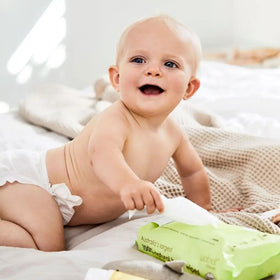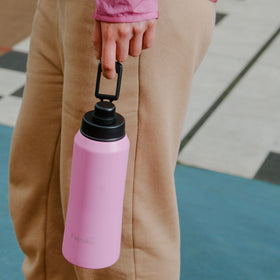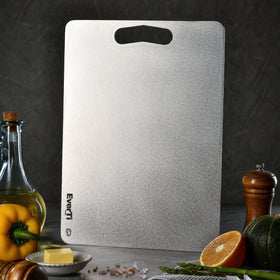
Nappy Change Essentials
When you've got a newborn baby, there's really not a lot that you need for them. A baby needs lots of love, food, somewhere to sleep, warm clothing, and they need to have their nappy changed regularly. Regularly means 10-12 times a day for newborns, and around 8 to 10 nappy changes a day by the time they're three months old. So, what are the essentials that you need for nappy changing?

Nappies
Obviously, you're going to need nappies. Disposable, eco disposable, cloth or hybrid? There's a lot of choice, which is why we put together our Nappy 101 guide. We usually recommend starting out with some eco disposables, even if you're going to use cloth nappies. The first month with a new baby can be overwhelming, and piles of extra washing on top of all the new baby stuff is not what you need. Hello Charlie has a range of tried and tested eco disposables, and we can help you to choose which one is best for you and your baby with some guidance from our Disposable Nappy Cheat Sheet. We also have samples of all of our eco disposables so that you can try them before you commit to a whole pack. When it comes to cloth and hybrid nappies, we've got a few great options that make life as easy as possible. You want cloth nappies that won't leak, that are easy to use, and will wash and dry easily. We highly recommend the award winning Pea Pods range of cloth nappies.
Wipes
You'll need something to clean up baby's bottom, so you're going to need some wipes. You're going to use a lot of wipes with all those nappy changes, so we recommend that you choose the safest and purest baby wipes. Newborn have very delicate, thin skin and should really only use cotton wool and water. You can choose cotton wool from the Simply Gentle range, or you could choose Waterwipes, which are 99.9% water and only 0.1% of a mild preservative. You can also go with cloth wipes, which you can use with water alone, or you can make up a baby wipes solution to go with your washable wipes. Of course, we've got a complete guide to the safest baby wipes in our Safer Baby Wipes Cheat Sheet, so that you can choose the best wipes for your baby.
Containment
That's the polite way of saying, what do you do with the poo? Poo, because it's human waste, shouldn't go into your bin. If you're using cloth nappies, you need to scrape it off, and rinse the nappy before you can wash it. As a mother, trust me when I say that this is much easier with a liner! You can go with the reusable liners that come with your cloth nappy or you can go with biodegradable, disposable liners. Disposable liners are the easiest way to deal with pooey disposables, too. Just lay a liner in the nappy, and then when your baby has made a nice pooey mess of it, just pull it out and pop it into the toilet. Biodegradable liners are actually flushable and biodegradable, not like so called 'flushable' wipes that clog up our sewerage systems. The great things about the disposable liners is that you can get at least three uses out of them if they're just wet. Wash them and dry them, and they're good to go again.
What do you do with the dirty nappies?
You can, of course, wrap your nappies in a plastic bag and throw them in the bin. But that's not very sustainable. If you're going to throw them into a bin or if you're out and about and need to contain the mess, skip the plastic bag, or go with a biodegradable one like the Wotnot bags. Incidentally, these are great for kitchen scraps and doggy bags, too! There are great wet bags available for cloth nappies, too, like the lovely waterproof wet bags from Pea Pods.
Nappy Rash Cream
You don't need to apply nappy rash cream at every change. As long as your baby is changed frequently, not left wet or dirty for too long, and gets some air on that baby bottom regularly, the odds are that you're not going to have any issues with nappy rash. If you do, you can check out some solutions in our Complete Beginner's Guide to Nappy Rash, and you can also find the best and safest nappy rash creams on our Safer Nappy Rash Cream Cheat Sheet. If your baby does have a bit of a red bottom, applying a good nappy rash cream for a few days should settle it down, and then you can skip it again until you need it.
Change mat
That soft, wriggly little body is going to need somewhere soft to be changed on. And you need to make sure that the soft place is also a washable place, because accidents are bound to happen! Whether you go with a dedicated change table, or whether you choose a temporary solution, it's handy to have a change mat. Both of mine were changed on a couple of towels (easy to wash). I put these on top of the chest freezer (perfect height and something we'd use when the kids had grown up), but I also had a portable change mat that went into the bottom of the pram or the nappy bag when we were out and about.
Organising
When your baby is tiny, you'll probably change them in the same spot. But once your baby is a wriggly toddler, sometimes you just need to pin them down and change them wherever you can. That's why it's so handy to have a nappy caddy or storage container for all your nappy change gear. You can grab it and head to where your toddler is. Then you can wrestle them down and change them before they've realised what's happening. We love the 3 sprouts storage caddies because they're just so cute, plus they're great for storing all manner of gear once you're through the nappy stage. The bbox nappy caddies have handy drawers and a portable change mat.










